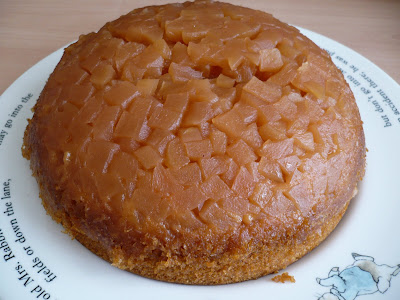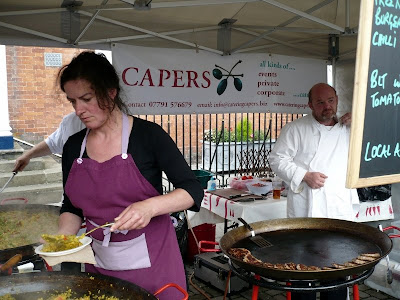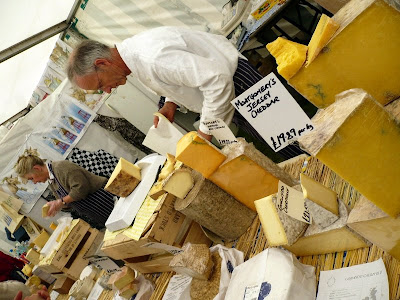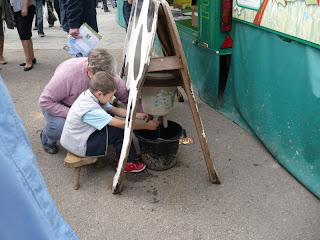
I remembered reading something about the celebrity chef Giorgio Locatelli concocting all sort of non-allergenic recipes for his daughter who is suffering from allergies to a number of food stuff. Thankfully Google yielded his recipe for an eggless and nutless chocolate cake. I just adapted it to cupcake sizes and reduced the baking time.
It came out quite nice actually in a non-rich cake sort of way. I baked it the night before my daughter took it to school. Come morning I took a bite of one and realised that it was not sweet enough and needed a sugar boost. So the next few minutes saw me frantically beating a chocolate icing worthy enough of this recipe. It was really hectic. My daughter was almost out of the door and I was still desperately trying to smear icing on the cupcakes!
Thank goodness the feedback from her classmates were quite positive. In fact, the teachers asked for some as well.
Eggless & Nutless Chocolate Cupcakes
450 g plain flour
2 tsp baking powder
1 tsp bicarbonate of soda
6 Tbsp unsweetened cocoa powder
350 g caster sugar
300 ml [scant 1 1/4 cups] water
2 Tbsp distilled white vinegar
125 ml [1/2 cup] vegetable oil
2 tsp vanilla extract
- Preheat the oven to 180°C/fan 160°C/350°F/gas mark 4.
- Mix the wet ingredients in one bowl.
- Sift the dry ingredients into another bowl.
- Slowly add the wet to the dry ingredients and beat until smooth.
- Pour into lined cupcake/muffin tin and bake for 20-25 minutes or a skewer poked in the middle comes out clean.
- Remove from oven and cool completely in wire racks.
- Add chocolate icing on top.
Chocolate Buttercream Icing
1/2 cup unsalted or slightly salted butter - softened to room temperature
1 1/3 cups icing sugar (confectioner's)
3 Tbsp cocoa powder
1/4 cup double cream
1/2 tsp vanilla extract
- Sift the icing sugar and cocoa powder onto the softened butter in a bowl. Beat until smooth.
- Add the double cream and vanilla. Beat until well mixed.
- Pipe or swirl on top of cupcakes.
Tenderstem broccoli has been in supermarket shelves of my local supermarket for quite sometime now but it's only recently that I got to try it. It wasn't hard to convince me since I like the regular broccoli. This tenderstem is a cross between Chinese kale and broccoli. Its appearance is similar to the Chinese gai lan with a slender and tender stem and a darker colouring than broccoli.
October's recipe in our BBC GoodFood calendar has this pasta recipe using the tenderstem. I've been eyeing it for a full month before I organized all the ingredients. And stupid me, even when I was mixing the herbs and pine nuts, did not realise I was making a rough pesto. Duh!
This dish is a welcome change to our usual spag bol, meatballs, or baked pasta that we have week in-week out. I must say it's quite healthy, too, what with those dark green tenderstem, herbs, and pine nuts.
Autumn Pasta
1 garlic clove - finely chopped
25 g toasted pine nuts - chopped
1 Tbsp chopped flat-leaf parsley or basil
4 Tbsp extra virgin olive oil
25 g parmesan - coarsely grated
200 g tenderstem broccoli
100 g Chanterelle or chestnut or other wild mushrooms - sliced
2 slices Parma ham or streaky bacon - cut in long strips
175 g spaghetti
- Chop finely half of the tenderstem broccoli and slice the rest in half diagonally.
- Drop the chopped tenderstem in a pan of boiling water, cook for 2 minutes. Drain and put into a bowl.
- Add in the parmesan, pine nuts, garlic and parsley into the cooked tenderstem.
- Drizzle 3 Tbsp of the olive oil and season with salt and pepper. Toss well.
- Cook the spaghetti according to the package instructions but 3-4 minutes before the end of cooking time add in the sliced tenderstem.
- While the spaghetti is cooking, heat the remaining 1 Tbsp olive oil in a frying pan. Fry the parma ham or bacon then drain on some paper towels.
- Add mushrooms to the pan and fry for 3-4 minutes. Season with pepper.
- Drain the spaghetti and sliced tenderstem in a colander. Return to the pot and toss with tenderstem pesto and and the mushrooms.
- Serve onto warmed bowls topped with the crisp parma ham or bacon.
 I've gone over to the dark side ... the dark side of caramel syrup I mean. I got so distracted with John Sargeant's dance of the pasa doble in Strictly Come Dancing's current season. The hilarity of seeing him dragging Kristina Rihanoff like a man taking out the rubbish was enough to make me forget the caramel syrup I was boiling. Let's just say it got quite dark with just a tinge of bitterness in it which I think is fabulous. So a thank you is in order to John and Kristina for making me burn the syrup. Hehehe!
I've gone over to the dark side ... the dark side of caramel syrup I mean. I got so distracted with John Sargeant's dance of the pasa doble in Strictly Come Dancing's current season. The hilarity of seeing him dragging Kristina Rihanoff like a man taking out the rubbish was enough to make me forget the caramel syrup I was boiling. Let's just say it got quite dark with just a tinge of bitterness in it which I think is fabulous. So a thank you is in order to John and Kristina for making me burn the syrup. Hehehe!
Now getting back to baking, this month's Daring Baker's challenge is - Caramel Cake by Shauna Fish Lydon of Eggbeater and an optional Golden Vanilla Caramels from Pure Dessert by Alice Medrich. It would have been a tragedy had I not made the latter since me and my family including all my work colleagues and all the classmates of my three kids ABSOLUTELY loved those chewy caramels. Never in my life have I encountered such moreish morsels of sweetness. Once you begin it's quite hard to stop. You have been warned!
As for the cake itself, it was lovely and really really appropriate for my birthday. Definitely a keeper though I'll just have to tone down the sweetness of the icing since it also has that caramel syrup glaze. As you can see from the last picture below, I got to practice my icing piping skills though the drizzling of the caramel was a bit of a disaster. Not to worry, afterall it's for my family's consumption so the caramel catastrophe lasted for quite a finite amount of time.
The fantastic group among the Daring Bakers who are the responsible for this are: Dolores of Chronicles of Culinary Curiosity, Alex of Blondie and Brownie, Jenny of Foray into Food, and Natalie of Gluten-a-Go-Go.
So without further ado, here are the recipes:

with Caramelized Butter Frosting
155 g [scant 2/3 cup] unsalted butter - softened at room temperature
1 cup granulated sugar
1/2 tsp fine salt
2 eggs - room temperature
1/2 tsp vanilla extract
2 cups plain flour
1-1/2 tsp baking powder
1 cup milk - room temperature
1/3 cup caramel syrup (recipe below)
- Preheat oven to 180°C/fan 160°C/350°F/gas mark 4. Grease a deep 9-inch/23cm round cake pan.
- Sift flour, baking powder, and salt together. Set aside.
- With an electric mixer, cream or beat the butter and sugar until light and fluffy.
- Add the caramel syrup into the bowl slowly while mixing.
- Add eggs one at a time making sure to mix well after each addition.
- Add vanilla extract. Mix well.
- Using a spatula or wooden spoon, fold one third of the flour mixture into the butter mixture.
- When incorporated, add half of the milk a little at a time.
- Add another third of the flour then add half of the milk and finish with the last third of the flour mixture.
- Pour the batter in the greased cake pan.
- Bake for about 45 minutes or until a skewer inserted in the middle comes out clean.
- Cool completely before icing it. Cake will keep for three days at room temperature.
Caramel Syrup
2 cups granulated sugar
1/2 cup water
1 cup water - for stopping caramelization process
- In a small stainless steel saucepan with tall sides, mix water and sugar. Brush down any stray sugar crystals with wet pastry brush.
- Bring to boil in high heat. Cook until smoking slightly and the colour becomes dark amber.
- Very carefully pour in one cup water. Caramel will jump and splutter about. Be careful!
- Stir over medium heat until it has reduced slightly and feels sticky between two fingers. (Obviously wait for it to cool in a spoon before touching it.)
- Remove from heat and cool completely. Syrup may be stored in jars.
Caramelized Butter Frosting
3/4 cup unsalted butter - softened
200 g [1-1/2 cups] icing sugar (confectioner's) - sifted
5 Tbsp double cream
2 tsp vanilla extract
2-3 Tbsp caramel syrup
sea salt to taste
- Cook butter in a saucepan until brown (about 5 minutes). Strain through a fine mesh sieve and set aside to cool.
- Beat melted butter in a bowl while adding icing sugar a little at a time.
- Add double cream and caramel syrup. Add salt to taste.
Golden Vanilla Caramels
1 cup golden syrup
2 cups granulated sugar
3/8 tsp fine sea salt
2 cups double cream
3 Tbsp unsalted butter - cut into chunks, softened
4 tsp vanilla extract
- Line a 9-inch/23cm square baking pan with aluminium foil and grease the foil.
- Combine the golden syrup, sugar and salt in a heavy saucepan.
- Cook over medium heat while stirring with a wooden spoon until it begins to simmer around the edges.
- Wash the sugar and syrup from the sides with a pastry brush dipped in water.
- Cover and cook for 3 minutes. Meanwhile, rinse the wooden spoon before using it again.
- Uncover the pan and wash down the sides once more.
- Attach a deep frying or candy thermometer to the pan, making sure it does not touch the bottom.
- Cook uncovered without stirring until the mixture reaches 305°F.
- Meanwhile put the double cream in a small saucepan and heat until tiny bubbles form around the edges of the pan. Turn off heat and cover the saucepan to keep it hot.
- When the sugar mixture reaches 305°F, turn off heat and stir in the butter.
- Gradually stir in the hot cream. It will bubble up and steam dramatically so be careful.
- Turn the heat back on and adjust it so that the mixture boils energetically but not violently.
- Stir until any thickened syrup at the bottom of the pan is dissolved and the mixture is smooth.
- Continue to cook, stirring occasionally, to about 245°F.
- Then cook while stirring constantly to 260°F for soft chewy caramels or 265°F for firmer chewy caramels.
- Remove pan from heat and stir in the vanilla extract.
- Pour the caramel into the prepared cake pan.
- Let it cool completely and set for 4 hours or overnight or until firm.
- Lift the foil liner from the pan and invert the caramel onto a sheet of baking parchment paper. Peel off foil liner.
- Cut caramel with oiled knife. Wrap each caramel individually in wax paper or cellophane.
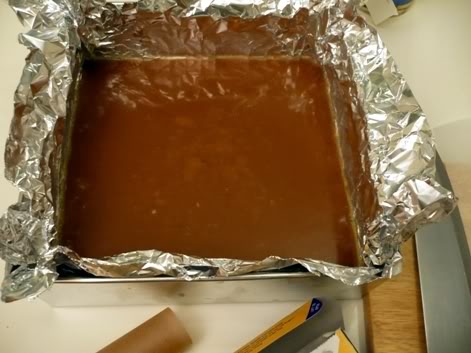

I have also noticed in the past few months that our TV viewing habits are changing. The prevalence of more and more TV shows and movies available through the internet means we are watching more of these in our PCs and laptop. Take for example our favourite BBC shows like Heroes, Dr. Who, Spooks, Strictly Come Dancing, etc. We don’t have to rush home to catch them or setup our VCR to tape them. All we have to do is go to the BBC iPlayer website and have a pick and mix of our favourite shows. Even in buying copies of them, recently iTunes have been helpful since they’re not only selling TV show episodes but also movies besides their usual music.
I guess the only drawback from watching in the PC is the limitation of the size and resolution of your monitor. It’s really best to watch shows in LCD TV. The sharpness of the images and gorgeous colours are just superb. There’s always been an ambition to buy a large one, you know the kind that fills a whole wall, when funds are available. That’s why we’re always on the lookout for bargains on LCD TV, PCs, laptops, and other electronic goods. One easy way we do this is see price comparisons in growing number of websites such as Savebuckets which lists the best prices for various consumer goods of a number of shops such as Currys, PC World, etc. We have used them several times and they are quite reliable and up to date.
I saw these wonderful pictures made of entirely food stuff like vegetables, fruits, bread, you name it he uses it. Buying copies of them and hanging them in our kitchen would be really cool. Have a look in the online version of the Telegraph - click here. You can get them here if you're willing to shell out a bit of money.
It was my birthday 2 weeks ago and as accustomed I baked some goodies for my family and colleagues at work. A ginger cake is always welcome with the people I work with and my old standard recipe never fails. This year I decided to try another from my well-thumbed 101 Cakes & Bakes of BBC GoodFood. It's not as dark as my old one but equally delicious and very gingery as well. The icing recipe is provided below but I used the icing of the old one to drizzle on it. Nice it was.
Ginger Cake
200 g unsalted butter
175 g molasses sugar
3 Tbsp black treacle
150 ml [scant 2/3 cup] milk
4 pieces stem ginger - drained and finely chopped
2 eggs - beaten
1 Tbsp ground ginger
1/8 tsp fine salt
300 g self-raising flour
*Icing:
4 Tbsp ginger syrup (drained from the jar of the stem ginger)
300 g golden icing sugar (confectioner's) - sifted
140 g unsalted butter - softened
2 tsp lemon juice
- Grease and line the bottom of a 23cm/9-inch round cake pan. Preheat oven to 160°C/fan 140°C/325°F/Gas mark 3.
- Mix the flour, ground ginger, and salt in a bowl. Combine thoroughly. Set aside.
- Gently melt the butter, sugar, and treacle in a saucepan. Remove from heat and transfer to a heatproof bowl. Cool slightly.
- Beat in eggs then add the chopped stem ginger.
- Fold in the flour mixture and make sure to combine thorougly.
- Pour the batter into the prepared cake pan and level the surface.
- Bake for about 40-45 minutes or until a skewer poked in the centre comes out clean.
- Cool in the cake pan for about 1 hour and then transfer to a wire rack.
- Prick the top of the cake all over then drizzle 2 Tbsp of the ginger syrup on top.
- Beat together the icing sugar, butter, lemon, and the remaining ginger syrup. Drizzle all over the cake.
Everyone in my family knows I'm a sucker for kitchen equipments. If my husband has an electronics catalog for bedtime reading, I would almost always have either a cookbook or a kitchen catalog. You know me, lusting for those kitchen items that would make my baking and cooking life a breeze besides the ones that are essential for the everyday needs of a kitchen diva like me. ;)
Since I spend an inordinate amount of time in the Internet, it is but inevitable that I would surf over to websites serving the needs of the kitchen enthusiasts. And since I'm skint as well I'm always on the lookout for ones that offer good value for money. Specifically those that have restaurants supplies and equipments are my favourites. They most certainly offer hard-wearing and durable equipments at reasonable prices.
 When my sister-in-law, who's based in America, asked for recommendations of websites to buy chafers for her upcoming party I readily gave her US-based sites such as Lion's Deal which offers some excellent kitchen equipment discounts for their good quality products. For someone like her who loves sales deals, it was like a magnet for her attention. I myself have always wanted chafers if ever I want to host a party. Asian food are almost always served hot so equipments to keep them piping hot is essential. I especially love them with roll-top covers like the one above. Hmmm ... until when am I gonna dream on?
When my sister-in-law, who's based in America, asked for recommendations of websites to buy chafers for her upcoming party I readily gave her US-based sites such as Lion's Deal which offers some excellent kitchen equipment discounts for their good quality products. For someone like her who loves sales deals, it was like a magnet for her attention. I myself have always wanted chafers if ever I want to host a party. Asian food are almost always served hot so equipments to keep them piping hot is essential. I especially love them with roll-top covers like the one above. Hmmm ... until when am I gonna dream on?
 It's the first time I've baked pizza completely from scratch - well actually I didn't make the mozarella and pepperoni - but other than those I made ones from raw flour, yeast, etc. to make the dough. I especially like the dough kneading and rising. One tick in my list of things I wanted to do all my baking life plus one less block off my phobia of yeast.
It's the first time I've baked pizza completely from scratch - well actually I didn't make the mozarella and pepperoni - but other than those I made ones from raw flour, yeast, etc. to make the dough. I especially like the dough kneading and rising. One tick in my list of things I wanted to do all my baking life plus one less block off my phobia of yeast.
I love the texture and billowy softness of the dough after the overnight rising. It was like a baby's bottom. Though it's also this quality that makes it a bit tricky to stretch and toss since the softness makes it so easy to expand it too thin. My dough actually suffered holes in the first two times which reminded me not to do too much stretching. Only one toss is for me is enough. More than one toss and you're really stretching it too far.
The Daring Bakers are the 'culprits' in this latest experimentation. This month's theme is currently hosted by Rosa and is also done in memory of Sherry who was supposed to be the co-host until her untimely death last July of a massive heart attack. Here's to you Sherry wherever you are.
It's funny, we were asked by Rosa to take pictures of ourselves tossing the pizza but my kids were more afraid of me dropping the dough on them or worse on the floor. Nothing of the sort happened of course but no picture materialized.
I know what you're gonna say - why make a boring pepperoni pizza? Well it's the topping that my family likes so I don't really care what anyone says. Also, for me to experiment I have to start from the most basic before moving on to more adventurous pastures. Avoiding waste was also in mind since I was wary that it would all go wrong so I don't really want to buy exotic pizza toppings for now.
I don't have a pizza stone so I thought the next best thing would be to use the smooth underside of my cast iron grill. It worked particularly well if I must say so, turning out crisp evenly baked crust.
My problem was in the transferring of the assembled pizza to the hot cast iron pan in the oven. I didn't have any semolina or cornmeal to slide it in easily. So I used a lot of flour on the chopping board though it doesn't work all the time which sometimes make the pizzas into odd shapes. Well, rounded or not the pizzas were gobbled up as soon as they come out of the oven. So the irregular shape really does not matter as much as the all important taste.
I'd just like to say thank you for the great dough recipe which is adapted from The Bread Baker's Apprentice by Peter Reinhart. It's something that me and my family would definitely have again and again.
Basic Pizza Dough
4 1/2 cups white bread flour, chilled
1 3/4 tsp fine salt
1 tsp instant yeast
1/4 Cup olive oil or vegetable oil
1 3/4 Cups water, ice cold (4.5°C/40°F)
1 Tbsp sugar
Semolina/durum flour or cornmeal for dusting
*Day One
- Mix together the flour, salt and instant yeast in a big bowl.
- Add the olive oil, sugar and cold water and mix well with a wooden spoon to form a sticky ball of dough.
- On a clean surface, knead for about 5-7 minutes, until the dough is smooth and the ingredients are well distributed. If it is too wet, add a little flour (not too much, though) and if it is too dry add 1 or 2 teaspoons extra water.
NOTE: If you are using an electric mixer, switch to the dough hook and mix on medium speed for the same amount of time.The dough should clear the sides of the bowl but stick to the bottom of the bowl. If the dough is too wet, sprinkle in a little more flour, so that it clears the sides. If, on the contrary, it clears the bottom of the bowl, dribble in a teaspoon or two of cold water. The finished dough should be springy, elastic, and sticky, not just tacky, and register 10°-13°C/50°-55°F.
- Flour a work surface or counter. Line a baking sheet with baking paper/parchment. Lightly oil the paper.
- With a metal or plastic dough scraper, cut the dough into 6 equal pieces. You may weigh them to divide them equally. Each piece should be about 180 gm in weight.
NOTE: To avoid the dough from sticking to the scraper, dip the scraper into water between cuts.
- Sprinkle some flour over the dough. Make sure your hands are dry and then flour them. Gently round each piece into a ball.
NOTE: If the dough sticks to your hands, then dip your hands into the flour again.
- Transfer the dough balls to the lined baking sheet and mist or brush them generously with spray oil. Slip the pan into plastic bag or enclose in plastic food wrap.
- Put the pan in the frige and let the dough rest overnight or for up to three days.
NOTE: You can store the dough balls in a zippered freezer bag if you want to save some of the dough for any future baking. In that case, pour some oil(a few tablespooons only) in a medium bowl and dip each dough ball into the oil, so that it is completely covered in oil. Then put each ball into a separate bag. Store the bags in the freezer for no longer than 3 months. The day before you plan to make pizza, remember to transfer the dough balls from the freezer to the refrigerator.
*Day Two
- Exactly 2 hours before you make the pizza, remove the desired number of dough balls from the refrigerator. Dust the counter with flour and spray lightly with oil. Place the dough balls on a floured surface and sprinkle them with flour. Dust your hands with flour and delicately press the dough into disks about 1/2 inch/1.3 cm thick and 5 inches/12.7 cm in diameter. Sprinkle with flour and mist with oil. Loosely cover the dough rounds with plastic wrap and then allow to rest for 2 hours.
- At least 45 minutes before making the pizza, place a baking stone or a cast iron pan upside down (you will use the underside of the pan for baking) on the upper third of the oven. Preheat the oven as hot as possible (around 260°C/fan 240°C/500°F).
- Generously sprinkle the back of a jelly pan or chopping board with semolina/durum flour or cornmeal. Flour your hands (palms, backs and knuckles). Take 1 piece of dough by lifting it with a pastry scraper. Lay the dough across your fists in a very delicate way and carefully stretch it by bouncing it in a circular motion on your hands, and by giving it a little stretch with each bounce. Once the dough has expanded outward, move to a full toss.
NOTE: Make only one pizza at a time. During the tossing process, if the dough tends to stick to your hands, lay it down on the floured counter and reflour your hands, then continue the tossing and shaping. In case you would be having trouble tossing the dough or if the dough never wants to expand and always springs back, let it rest for approximately 5-20 minutes in order for the gluten to relax fully, then try again. You can also resort to using a rolling pin, although it isn’t as effective as the toss method.
- When the dough has the shape you want (about 9-12 inches/23-30 cm in diameter - for a 180 g/6 oz piece of dough), place it on the back of the jelly pan, making sure there is enough semolina/durum flour or cornmeal to allow it to slide and not stick to the pan.
- Lightly top it with sweet or savory toppings of your choice.
NOTE: Remember that the best pizzas are topped not too generously. No more than 3 or 4 toppings (including sauce and cheese) are sufficient.
- Slide the garnished pizza onto the stone in the oven or bake directly on the jelly pan. Close the door and bake for abour 4-6 minutes.
NOTE: After 2 minutes baking, take a peek. For an even baking, rotate 180°. If the top gets done before the bottom, you will need to move the stone or jelly pane to a lower shelf before the next round. On the contrary, if the bottom crisps before the cheese caramelizes, then you will need to raise the stone or jelly.
- Take the pizza out of the oven and transfer it to a cutting board or your plate. Rest it for 3-5 minutes before slicing or serving to allow the cheese to set a little.
 SHF was the very first blogging event that I joined way back in autumn of 2004. Those were the days when blogging was so new and exhilarating. You know almost all of the food bloggers by heart because there were only a few of us around that time. Now bloggers are in the thousands and that's just in the food category. How time flies.
SHF was the very first blogging event that I joined way back in autumn of 2004. Those were the days when blogging was so new and exhilarating. You know almost all of the food bloggers by heart because there were only a few of us around that time. Now bloggers are in the thousands and that's just in the food category. How time flies.
After a long while of not being able to participate in SHF, I made it a point to make sure I do it this time besides the fact that my blog needs the regular update once and again. The current theme of SHF is spice, hosted by Anita of Dessert First.
There were two choices for me to bake, either a spiced creme caramel or this mango upside-down cake. Well the sight of some Indian mangos in the supermarket did it for me. And so it was, only if I waited a little longer for it to ripen the cake would have been perfect. But that is the point of trying, isn't it? Give it a go, if it's not to your liking then do adjustments the next time.
As for cardamom, I fell in love with this spice when I started sampling Indian sweets. I love its heady aroma and the way it melds well with ingredients like chocolate. I will surely be making use more of this fragrant spice.
Paul Rankin's recipe is the one I adapted from the BBC GoodFood magazine of November last year.

160 g butter - softened
100 g caster sugar
2 large eggs
175 g self-raising flour
2-3 Tbsp milk
1 Tbsp lime or lemon juice
lime or lemon zest (optional)
2 Tbsp soft brown sugar
2 cardamom pods, seeds only, crushed
1 slightly ripe mango - peeled and sliced
- Preheat oven to 190°C/fan 170°C/375°F/gas mark 5.
- Beat 100 g of the butter with the caster sugar in a bowl until light and fluffy.
- Add the eggs one at a time, beating well after each addition.
- With a wooden spoon, fold in the flour.
- Add the milk and mix to a soft dropping consistency. If it is too thick, add more milk.
- In a 20 cm oven-safe frying pan, melt the rest of the butter (60 gm) with the brown sugar, cardamom, lemon zest and lemon juice. Stir to mix.
- Add the mango slices and cook for about 5 minutes or until it is a bit soft but still firm. If you're using a separate baking pan instead of the frying pan, pour the mango slices into the baking pan.
- Arrange the cooked mango slices well at the bottom then spoon the cake batter on top.
- Bake for 20 minutes or until risen and beginning to shrink away from the sides.
- Remove from oven. Slide a knife around the edges of the pan then turn the cake out onto a serving plate. Serve warm with some Greek yoghurt or cream.
This is one long post on a wonderful food-filled day two Sundays ago at the Ludlow Food Festival. I've always liked that market town where amidst the fascinating old timbered buildings and its castle it regularly has a farmer's market every Monday, Wednesday, Friday, and Saturday in the square opposite the entrance to the castle. This time in addition to the market lots of stalls and demonstration tents were assembled inside the castle grounds by the organisers to highlight and celebrate all the wonderful produce around the Marches (the England-Wales border area).
[Click on the pictures for a bigger view]
Just look at the beautiful timber-framed old buildings in Ludlow's streets. This is the old Feathers Hotel which used to be the residence of Rees Jones a lawyer for the Council of the Marches area sometime in the early 1600s.
Old buildings in Ludlow are not only preserved but used quite well. These parade of shops are very interesting to behold indeed with the ancient buildings they are housed.
The main festival was within the castle grounds but the festivities and exhibitions were not confined there. Numerous other shops, pubs, and restaurants in Ludlow laid out tables outside to sell their wares and of course the regular market was in full swing as well.
Before we went inside we had lunch among the food stalls that came out especially for this 3-day event. I got my lovely paella from this stall. £3.00 for a small plate that had 2 slices of chorizo in it, chicken, some veg and lots of flavourful Spanish rice. Yum!
My daughters had their usual jacket potato with cheese (no baked beans this time). They raved on the deliciousness of the potato and cheese from this stall so much so that my youngest insisted on getting another one on our way home. So we'll keep them in mind if we come across them next time.
Lechon! Look at that steaming hot roast pork being pulled into shreds. Over here roast pork is eaten one way by putting the shredded meat in a bun with gravy. It's nice but I prefer mine in chunks with liver sauce. Better yet any leftovers stewed in liver sauce as Lechon Paksiw. Okay we're digressing a bit ... let's get back to Ludlow. See all those shops and food above - that's just outside of the festival grounds. And now we come to view the festival itself.
As I said before, the festival was in the grounds of Ludlow castle now a ruin. The castle had a very rich history which was very much entwined with the history of English throne. It was here that Prince Arthur (Henry VIII's elder brother) died while on honeymoon with his bride Catherine of Aragon who after his death became Henry VIII's first of six wives.
Entrance fees are a reasonable £6.00 for adults and £2.00 for kids. Then they give you this red wrist band to separate you from the racing pigeons. ;)
Here was a map of the place in case you need to find yourself.
There were loads of stalls of small scale producers. Come to think of it I didn't see any big-named companies there except probably for Tyrell's who was the main sponsor. But then they're not really that big - yet.
Oh yes there's one for Veuve Clicquot champagne where you can dine with some hot seafood dishes with your champagne.
I've always wondered how apples juices are extracted and this traditional press was on hand to show us how.
He must be feeling really hot in front of that pizza oven. We saw him sitting there all day.
I nabbed 3 bags of different flours plus a nice hessian bag from this stand. Bacheldre Watermill produces stoneground flours of very good quality. Later I will definitely blog about the results of my baking using their flours.
We love this bottled spring water. For me it tastes like very clean rain water. Really soothing to drink especially when chilled. We definitely recommend Wenlock spring water if you ever have a chance to come across it.
They have several huge tents where most of the smaller producers exhibited or sold their products. There were a large variety of exhibitors which range from farms showing their meat products (see previous picture collage) to ice cream makers, vegetable retailers, etc. The following were also in the tent:
Quite a number there were small breweries making distinctive ales and spirits. As expected these were very popular with the male guests.
Chocolate makers, other sweet producers and bakers were also on hand. Though there were not too many of them.
Lots of dairy producers were in attendance. We like the organic yoghurt of The Dairy House. They were very creamy and had lots of different interesting flavours.
Cheese galore!
Some non-edible things were also there in the form of cookbooks (still food-related).
These are well crafted hand-made ceramic products in fun and colourful designs.
Fancy smoking your salmon while driving? It can be done!
The army came in culinary force as well, treating people to some inexpensive but tasty soup and bread.
The music on offer were top-notch as well. Good enough to make a whole gaggle of people crowding in front of them while scoffing their tasty nibbles and drinks.
This trio on the other hand entertained people who patronized the cafe in the dry moat of the castle. They were very good, too.
They even have the resident fairy to sprinkle twinkly dust on everyone. ;) Well actually these are visitors as well, why they dressed like that I've got no clue. Must be a hen party? But he's a bloke ...
The little ones were not neglected. A circus tent was provided where they can try out different circus skills under the guidance of some circus masters.
They even make the kids do some artificial milking. :) How cute.
I've been very complimentary of this festival and its exhibitors. I just want to make it clear that I am in no way affiliated with any of them nor was I paid to do any kind of advertisement. I am just happy, despite previously moaning about the dearth of foodie places in the West Midlands, to discover all these artisanal producers almost at my doorstep. It's so heartening to know that they're out there in the countryside. I just have to drive about 25 miles west and I'm in foodie country!










 When my sister-in-law, who's based in America, asked for recommendations of websites to buy
When my sister-in-law, who's based in America, asked for recommendations of websites to buy 

